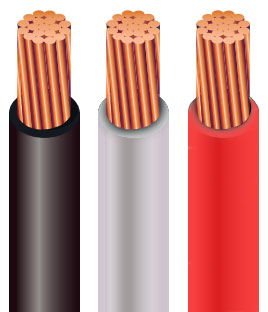
Advantages of PV Wire
- Reliable performance at high temperatures. PV wires can perform in direct sunlight on rooftop or field systems without shade or protection.
- Resistance to the elements and environmental wear. PV wires are insulated and durable enough to withstand wind, rain, and UV-related wear over time.
- XLPE insulation. XLPE insulation offers good dielectric strength and insulation qualities, as well as better resistance to temperature damage.
- Ratings of over 600V. We provide PV wire in multiple voltage standards to best fit different systems.
- Direct burying capabilities without shielding demands. Our wiring is built for direct burying potential without the need for shielding.
How to Select the Right PV Wire:
- Conductor Size. The conductors in PV systems tend to range from 18 AWG through 2000 kcmil. The wiring for each component needs to be able to handle the conductor’s upper limits.
- Conductor Material. Typical wiring for all electrical systems are made from either copper or aluminum, which can conduct electricity with relatively little resistance or energy loss. PV systems can benefit from using copper-coated or copper-clad aluminum wiring.
- Insulation. Insulation is crucial for protecting the wiring from moisture, heat, UV, or chemicals. In PV applications, it is important to choose an insulation material that can resist sunlight and handle high voltage levels, such as XLPE or EPR.
- Voltage. Three standard levels in PV systems are 600 V, 1 kV, and 2kV. Choose the right wiring based on the specific needs of your equipment.
- Sunlight Resistance. Because PV systems need to be in direct sunlight for full utilization, the materials are exposed to an extraordinary amount of sunlight and UV radiation. The wiring must be coated in a sunlight-resistant material to avoid breakage, brittleness, and degradation.
- Temperature Rating. UL 4703 establishes the temperature ratings for PV wiring at 194°F for wet wiring and 221°F, 257°F, or 302°F for dry wiring.
- Optional Direct Burial Rating. This type of wiring can be directly buried without the need for shielding, according to the NEC.
- Optional Multi-Ratings. The two optional multi-ratings under the UL standards are USE-2 and RHW-2.
- Construction. PV wiring is a single-conductor type of wiring. It is also non-armored.
PV Wire should be designed to eliminate or greatly reduce chance of damage from things like:
- Environmental Damage – Since solar cables and wires are used primarily outdoors, it is crucial that they withstand a wide temperature range and resist weather, ozone, and UV radiation. PV wires may also benefit from additional reinforcements, such as metal mesh or wrapping, to protect against rodents and other pests.
- Mechanical Damage – PV wiring and cables will be subject to wear and tear, so it’s important that they withstand mechanical and abrasion damage from movement, debris, and maintenance. They must also be able to withstand mechanical stress such as bending, compression, tension, and shear loads.
- Chemical Damage – Depending on the application, PV wires are often exposed to a wide variety of chemicals, such as acid rain, ammonia, oxalic acid, digester gases, caustic soda, and more. To avoid damage and corrosion, PV wiring should be resistant to chemicals and be acid or base proof.
- Electrical Damage – The wiring must be able to withstand fluctuation and electricity-related hazards. Good properties of wiring include temperature resistance, high dielectric strength, flame-retardance, and a short-circuit proof design.
At OneMonroe we have the expertise and experience to help you pick out the right PV wire for your project. We will ensure it not only meets your needs but exceeds them with a quality product at an affordable price. Call today to speak to one of our product experts and let us help you with your PV wire needs.

